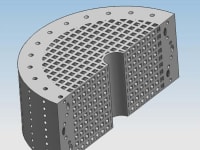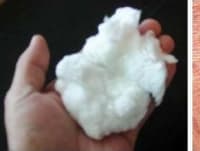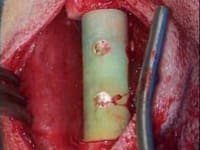
Product idea: Prototype synthetic bone scaffolds manufactured by selective laser sintering (SLS) using NOVEL BORATE-BASED BIOACTIVE GLASS (BBG) mimicking the structure and mechanical properties of normal healthy trabecular bone tissue and which can be used for trauma repair.
How it works: Medical imaging can provide non-destructive characterization of 3D bone density, structure, connectivity, and mechanical properties. Such information can be used for computer aided designing digital bone shapes, which is then feed to a SLS machine to fabricate “green” bone scaffold prototypes.
Innovation: While synthetic bone scaffolds are already available in the market, the use of BORATE BIOACTIVE GLASSES as new materials will provide scaffolds that resorb and heal faster and have potential for load bearing applications. The SLS process allows controlling gradient structural features (macro- and micro-size porosity) to provide high vascularization promotion as quick as possible. Figure 1 shows the CAD model of a partial bone shape used to make a physical model of the same geometry. Complex shapes can be fabricated with gradient features and/or including multiple compositions.
BORATE BIOACTIVE GLASSES are being tested in frontier research areas such as wound healing, hemostasis, nerve repair, and bio-composites. Figure 2 shows the healing of a chronic ulcer of a diabetic patient, showing minimal scarring. Table 1 lists the main hemostatic properties of a BBG nanofiber matrix compared to two commercial products, showing higher hemostatic capability. BBG is non-toxic, does not create inflammation (compared to zeolite powders), and there is no need to surgically remove debris as it degrades into hydroxyapatite. Preliminary tests indicate that peripheral neurons are unaffected by degrading BBG compositions and cross sections of hollow fibers (300 um diameter) act as blood vessels with tissue growing inside and around the fibers.
Table 1. Comparison of Hemostatic Properties of BBG Nanofiber to Commercial Products.
Reaction t(min) Clotting t (min)Coagulation % Lysis
Whole blood 9.0 2.3 -3.2 2.1
BBG nanofiber 1.2 1.3 4.4 1.5
Combat Gauze 3.5 1.4 2.7 3.0
Kerlix 8.1 2.5 -2.1 3.9
Application: These bone scaffolds can include biologically active reagents such as proteins and are being specifically designed for implantation in animals having a hollow cylindrical structure that can accommodate a metal pin through the longitudinal length of the scaffold. The scaffolds with and without bone morphogenic protein-2 (BMP-2), are being implanted after a 5 mm segment is removed from femurs of Long-Evans rats to create critical-sized defects which is stabilized using a stainless steel K-wire (Figure 3). A 3-month histology results show that the scaffolds provided sufficient strength to sustain the segmental defect until bridging callus is successfully formed.
How will be manufactured and marketed: Mo-Sci Corp. manufactures glasses for different applications and in several forms (powder, nanoparticles, fibers, nanofibers, solid and hollow microspheres, etc.). BORATE BIOACTIVE GLASSES are being made to feed a SLS machine at Missouri University of Science & technology and sintered at Mo-Sci Corp. In-Vivo evaluation is made at Indiana University. Commercial manufacturing and marketing will be done by Mo-Sci Corp.
-
Awards
-
 2012 Top 100 Entries
2012 Top 100 Entries
Like this entry?
-
About the Entrant
- Name:Mariano Velez
- Type of entry:teamTeam members:Steve Jung, Mo-Sci Corp.
Krishna Kolan, Missouri University of Science & technology
Ming Leu, Missouri University of Science & technology
T-M. Gabriel Chu, Indiana University - Software used for this entry:unigraphix, solidworks
- Patent status:pending








